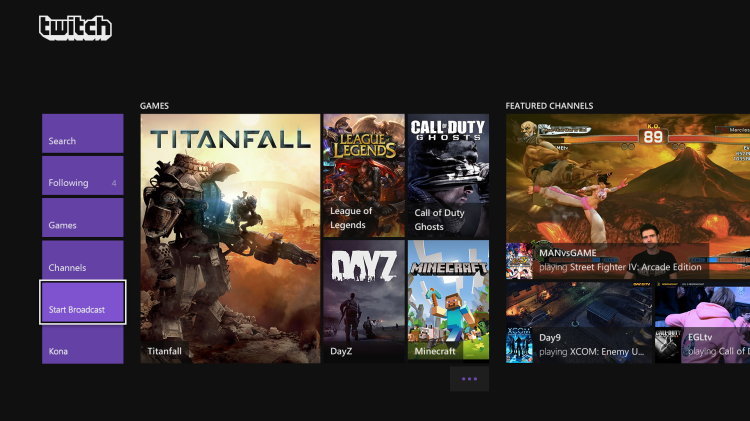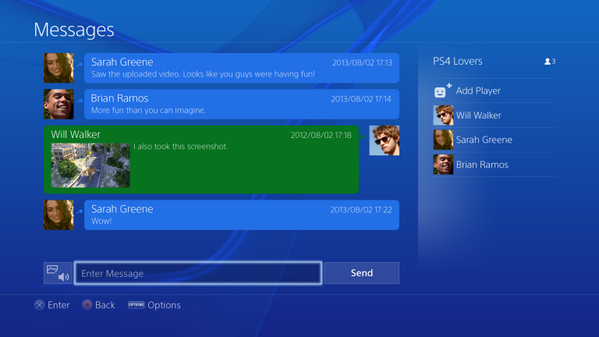Social is a foundation, not an add-on, for the PS4
When Sony began developing the PlayStation 4, incorporating cross-game chat was “a pretty significant priority,” according to John Koller, the vice president of platforms marketing at Sony Computer Entertainment of America. “It was one of several areas that we wanted to insure that was included. And I think, just to take a quick, broad overview of the PS4 development, at its core it was developed as a socially connected and very communal platform.”
Sony was already talking with Facebook and Twitter about how best to incorporate those services into their new console as far back as 2007. Sony wanted to make sure both services functioned on the PlayStation 4 right out of the box, without the requirement to download a separate app. “Each of them have various engineering requirements that we needed to follow, so it was very much hand-in-hand in terms of how we did that,” said Koller. These early design priorities make sense of Sony’s emphasis on the Share feature of the PlayStation 4 during the system’s reveal.
Sony considered integration with Twitch TV as just as important as their efforts with Facebook and Twitter. “Myself and some others here were initially pretty surprised in ’08 and ’09 about the sheer gravity that was going toward Twitch,” said Koller. “And at the time, to integrate with Twitch, a gamer had to really put together this kind of janky platform. We said, let’s make this as easy as we can.”
“We had one of the individuals who works on our digital team come down in ’09 and show an absolutely massive amount of people following one person who was playing Call of Duty at the time, and I have to say that personally I was very surprised,” Koller told me. “I looked at this, and I said, there’s something here.”
He was right. In January of this year, the official Twitch blog reported that between Dec. 23 and Jan. 3, 20 percent of Twitch’s broadcasters were from PlayStation 4 consoles. That’s one-fifth of the content from one of the most popular online gaming communities on the Web — and it’s a powerful marketing point for a company trying to position its console as a product for gaming first and foremost.
Microsoft’s late start with Xbox One’s social tools
Microsoft, on the other hand, retired the Facebook and Twitter apps from the Xbox 360 in October 2012, recommending that players take advantage of Internet Explorer on the Xbox 360 to interact with those social networking tools. To be fair, Facebook engineer Colin Creitz has stated that maintaining native apps on consoles was high maintenance, so this could have had something to do with Microsoft’s decision.
I asked Irving if he could give me some insight into why Microsoft removed those apps. “We retired the Facebook and Twitter apps in October 2012 when we released Internet Explorer for Xbox 360,” said Irving. “Adding Internet Explorer on Xbox gave Xbox Live subscribers the ability to access these sites through the browser optimized for their TVs, offering a more streamlined experience.”
In my experience, accessing Facebook and Twitter on the Xbox 360 through Internet Explorer is clunky. In fact, the only time I share Xbox 360 content with my friends on Facebook is when I play Minecraft, which has an easy tool for taking and sharing photos that conceptually sounds an awful lot like what the PlayStation 4 uses.
Irving gave me no indication that Microsoft has plans to approach Facebook and Twitter on the Xbox One any differently than they approach them on the Xbox 360. Microsoft may have no concrete reason to do otherwise at the moment. Sony isn’t trumpeting any statistics about Facebook and Twitter engagement by PlayStation 4 users, so Microsoft has no bar to chin up to. We just don’t know if Facebook or Twitter on these new consoles will actually amount to anything in the first place.
But the difference between how each company has tackled the issue of Facebook and Twitter does say something about the relative importance they place on social networking tools, and Sony’s approach has led to a success that I doubt anyone could have predicted and which may have a lot to do with their current lead over the Xbox One.
Microsoft also had no Twitch broadcast integration at launch. “We understand that the broadcasting component of Twitch is very important, and it is a major focus on our roadmap as we work to ensure it is seamlessly implemented on Xbox One,” Richard Irving told me in our interview earlier this month. Microsoft had chosen to focus on Twitch’s viewing audience rather than expanding its broadcaster base. “Unlike the PS4, Twitch on Xbox One will provide gamers with the ability to view Xbox One and Xbox 360 gameplay, as well as gameplay from PCs and other consoles.”
Microsoft announced on Feb. 25 that it would patch in Twitch broadcast capability to the Xbox One by March 11. That’s the same time-frame within which they’re addressing the shortcomings of Party chat and friends lists on the new console. Both decisions probably have everything to do with the imminent release of Titanfall, the sci-fi first-person multiplayer shooter that appears to be the first “must play” game for the Xbox One, and Microsoft’s recognition that they do not want to miss out on this important opportunity to hook their online player base into the Xbox community.
Setting the tone matters
More than ever, console cycles are marathons, not sprints. The Xbox 360 and PlayStation 3 evolved considerably from launch to the present, and it’s therefore unreasonable to look at the Xbox One and PlayStation 4 in their current forms, and with their current slates of functionality, as the definitive representations of those systems. Microsoft will also be the first company to release a game which might serve as a system seller.
Sony currently holds a decisive advantage in eighth generation console sales. Sony announced on Tuesday, March 4 total PlayStation 4 sales of more than 6 million units worldwide, while Microsoft’s most recent quarterly financial report cited the sale of 3.9 million Xbox One units worldwide. Sony claims that it sold twice as many PS4s as Microsoft sold Xbox Ones in January. You may also try your local retailers to see if you can find a PlayStation 4 on the shelf versus an Xbox One.
The amount of time the gaming audience spends on one console or the other translates into profits gained or lost. According to Nielsen data, last year 35 percent of monthly game spending in a household was spent on the Xbox 360 versus 19 percent for the PlayStation 3. And there’s a tiny difference in the consoles’ performances last year which speaks to the importance of digital media, when we consider that the PlayStation 3 was the clear choice over the Xbox 360 for entertainment appeal. Consumers spent 7 hours per week watching downloaded movies and television shows on the Xbox 360 and 4 hours per week doing so on the PlayStation 3.
It makes sense that if you have more users spending time online on your console, the more those users are exposed to your online marketplace and the more purchases they’ll make, in this case purchases of downloadable media. This shallow gain, as well as their overall dominance in online activity, might explain why Microsoft was so enamored with the idea of dispensing with physical media on the Xbox One.
It would be ironic if that gambit was responsible in large part for Sony’s early lead in the newest round of the console wars, inasmuch as it gave Sony a powerful marketing tool to align themselves with the game playing audience specifically. That and a $100 price difference surely have everything to do with how much stronger Sony has been out of the gate. The best way Microsoft can erase that lead and take over the number one position is by creating superior online community tools and, as in the last generation, inspiring the preponderance of online video game players to stick with Xbox brand, because that’s where more of their friends are.
At least for now.
VentureBeat's mission is to be a digital town square for technical decision-makers to gain knowledge about transformative enterprise technology and transact. Learn More



